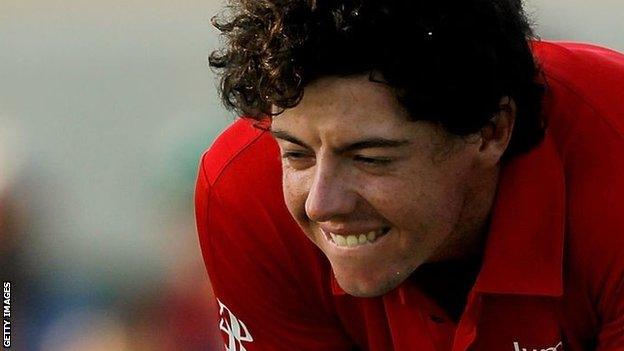US PGA Championship: Why Rory McIlroy faces tough Kiawah Island test
- Published
- comments

Rory McIlroy romped to an eight-shot victory when he won the 2012 US PGA Championship at Kiawah Island
US PGA Championship |
|---|
Venue: Kiawah Island, Ocean Course Date: 20-23 May |
Coverage: Live text commentary on BBC Sport website from first tee to final putt. Radio 5 Live Sports Extra from 21:00 BST |
Rory McIlroy was always going to be talked about before this week's US PGA Championship given the way he overpowered a supposedly fearsome Kiawah Island course, destroying the opposition the last time this major was played there.
Having won in his last outing at Quail Hollow two weeks ago, McIlroy now rates among the favourites to lift what would be his fifth major title. But it would be wrong to get too carried away with his chances.
Yes, the 32-year-old Northern Irishman thrives on confidence and has repeatedly gone on winning streaks at the highest level when his game falls into place. But he will need to be a lot more accurate with his driver to beat the world's best this week.
Back in 2012, when McIlroy triumphed at Kiawah, everything seemed to fall into place to allow him to collect his then second major crown. I remember the glint in his eye as he sat in his news conference on the eve of the tournament.
Many American observers were expecting a links-like test given the course's proximity to the Atlantic Ocean. They reasoned that this would suit UK players brought up on seaside golf.
McIlroy knew different and that conditions played into his hands. The qualities needed to take on a traditional links would be largely redundant because the course would play nothing like it.
It had been softened by recent rains that fed thirsty broad-leafed paspalum grasses, creating a sticky surface akin to the one he practiced on at the Bears Club in Florida.
These are the conditions that McIlroy likes most. Furthermore the Pete Dye design would not mess with his head quite as much as other layouts by the renowned architect.
"You're not hitting across as many fairways," McIlroy explained. "I think there's a few more targets to aim at in the horizon, whether it be a TV tower or a grandstand.
"Even if you're not comfortable with the shape of the hole, you can still just stand up there and you have your target and you hit it at it. It's a golf course that is more in front of you than maybe other Pete Dye courses are, so it's something that I quite like."
It was very much to his liking. McIlroy ended up 13 under par to finish eight shots clear of his closest rival, Englishman David Lynn, who is now a property developer.
McIlroy has his own infrastructure issues, with the immediate question on whether those lines are as easy to spot nine years on.
Grandstands are less necessary in these Covid times, although up to 10,000 spectators a day are expected to be allowed on the South Carolina course.
It remains a monstrous layout at 7,876 yards. "I want to punish these pros if they don't hit the proper shots," Dye said when he unveiled the course built for the 1991 "War on the Shore" Ryder Cup.
It is expected to play faster and firmer than it did back in 2012, when the PGA was an August major and there will be a premium on accuracy off the tee.
That could be a source of concern, even though McIlroy ended his 19-month winless drought in Charlotte earlier this month because he only hit 19 of 56 fairways in that victory.
He will need to be more accurate this week and he knows it. He admitted you could "poke holes" in his performance in winning the Wells Fargo Championship, but stated that the victory was "validation that I'm on the right track".
When he won in 2012, McIlroy ended a run of 16 majors won by different players. He arrives at Kiawah amid a similar trend that illustrates the strength in depth of potential winners for any men's major.
Since Henrik Stenson won the Open in July 2016, Brooks Koepka is the only repeat major winner, claiming four of the 17 majors played in that period. McIlroy is not among the list, he last won one of the big ones at the 2014 PGA.
Kiawah would suit a fully fit Koepka to a tee, but the Floridian continues to battle knee problems and could not take advantage of last week's birdie-fest in Dallas, where he missed the halfway cut.
"I think it's definitely a ball striker's course," said Collin Morikawa, the defending champion this week. "You have to be able to control your ball. You have to be able to flight different shots, work it left to right, right to left, and that kind of suits me.
"The greens are pretty small but starting from hole nine it's a very good finishing stretch of golf, especially with the wind. You're going to be tested on every shot."
World number one Dustin Johnson would be another to relish the challenge, but is an unknown quantity after pulling out of last week's Byron Nelson with a knee injury.
Could this be the major breakthrough for Jon Rahm? The Spaniard certainly possesses the muscular game and touch that will be required for victory and Justin Thomas has the power and short game to potentially add a second PGA title.
The reality, though, is that, as always, there are plenty of potential winners. Who's week will it be? After all, few if any foresaw Hideki Matsuyama's win in the last major, the Masters at Augusta.
And from McIlroy's point of view, this one may have come a little too soon against such strength in depth. But, at least he's in the conversation and not just because of what he did at Kiawah nine years ago.
